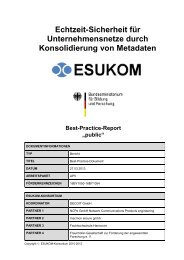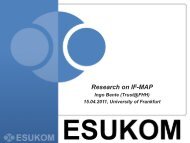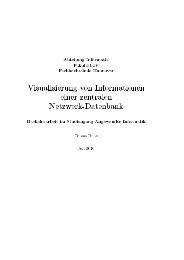Leveraging Trusted Network Connect for Secure ... - esukom
Leveraging Trusted Network Connect for Secure ... - esukom
Leveraging Trusted Network Connect for Secure ... - esukom
Create successful ePaper yourself
Turn your PDF publications into a flip-book with our unique Google optimized e-Paper software.
control and authorization process. Validation rules and conditions specified<br />
as technical security/ integrity policy have to be reliably en<strong>for</strong>ced. Such a<br />
policy might require the presence, status, and software version of mandated<br />
applications, and the OS patch level of the mobile device. Reassessment<br />
methods are required to en<strong>for</strong>ce post-admission control, i.e. revalidation, at<br />
regular time interval, of mobile device plat<strong>for</strong>ms that are already admitted to<br />
the enterprise network.<br />
c. Isolation and automatic remediation: in order to provide flexibility with<br />
regard to the isolation of critical enterprise networked resources from less<br />
critical ones, mobile devices should be reliably isolated and quarantined<br />
from the rest of the network if they fail to meet the security policy<br />
requirements <strong>for</strong> endpoint compliance. If allowed, smartphones and<br />
employees redirected to a quarantine zone should be provided with necessary<br />
security updates, helping them becoming compliant. In order to reduce the<br />
ef<strong>for</strong>t <strong>for</strong> per<strong>for</strong>ming such a strategy, especially in large-scale enterprise, the<br />
remediation process has to be automatic.<br />
d. Endpoints plat<strong>for</strong>m authentication: NAC mechanisms should enable<br />
mobile devices and employees to reliably detect rogue access requestors and<br />
rogue security gateways respectively. Furthermore, the proof of identity of<br />
communication endpoint (smartphones, access point or back-end servers)<br />
and the assessment of plat<strong>for</strong>m integrity of those devices have to be reliably<br />
verified.<br />
e. Support of federation of trust: since corporations defined different network<br />
access control and authorization policies, methods are required <strong>for</strong><br />
exchanging security attributes and integrity in<strong>for</strong>mation about a mobile<br />
device and about the employee associated with it across enterprises’ security<br />
domains. This is an important requirement considering corporation<br />
boundaries becoming more elastic and mobile devices roaming between<br />
different corporations’ networks.<br />
f. Usability: NAC solutions should be designed while keeping both network<br />
administrators and end users’ (employees) conveniences in mind.<br />
2.4 <strong>Trusted</strong> <strong>Network</strong> <strong>Connect</strong> (TNC)<br />
With the TNC specification, the TCG developed an open and vendor-neutral<br />
specification <strong>for</strong> the integrity check of communication endpoints, which requests<br />
access to a resource. The architecture supports existing and well-established security<br />
technologies such as VPN, 802.1X, Extensible Authentication Protocol (EAP) and<br />
RADIUS. The TCG’s TNC offers hardware support by means of the <strong>Trusted</strong> Plat<strong>for</strong>m<br />
Module (TPM), so that e.g. the accuracy of the plat<strong>for</strong>m integrity in<strong>for</strong>mation used in<br />
the network access control process is guaranteed. Built in desktop PCs and notebooks<br />
this integrated chip protects data on a hardware level. Together with 802.1X, it<br />
guarantees the TNC architecture, so that solely certificated (digitally signed)<br />
application software may be used. Furthermore, this technology uses an authorization<br />
token (e.g. a X.509 certificate), which is communicated together with the client status





